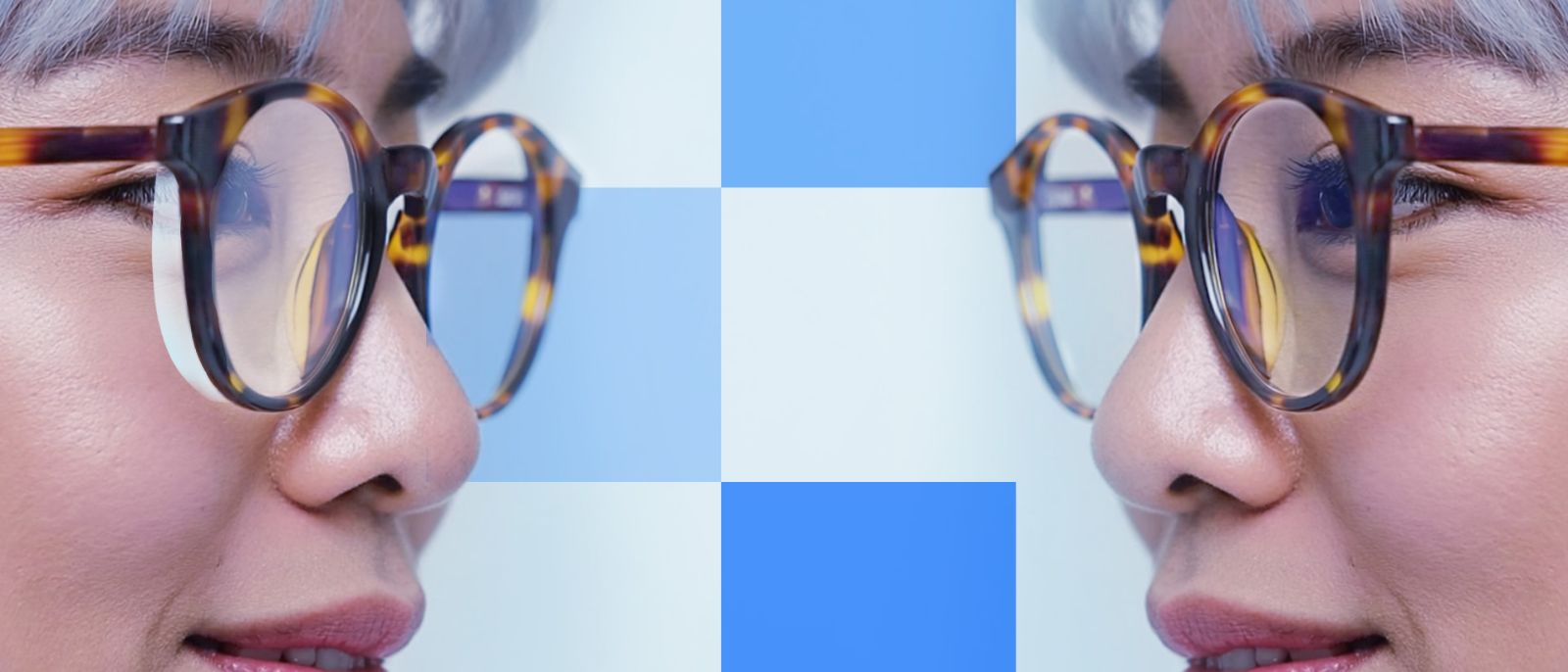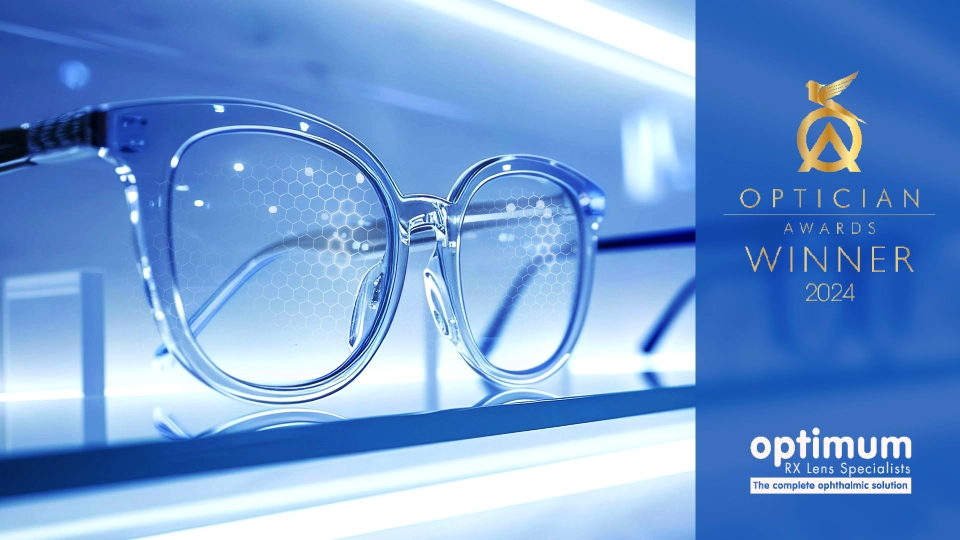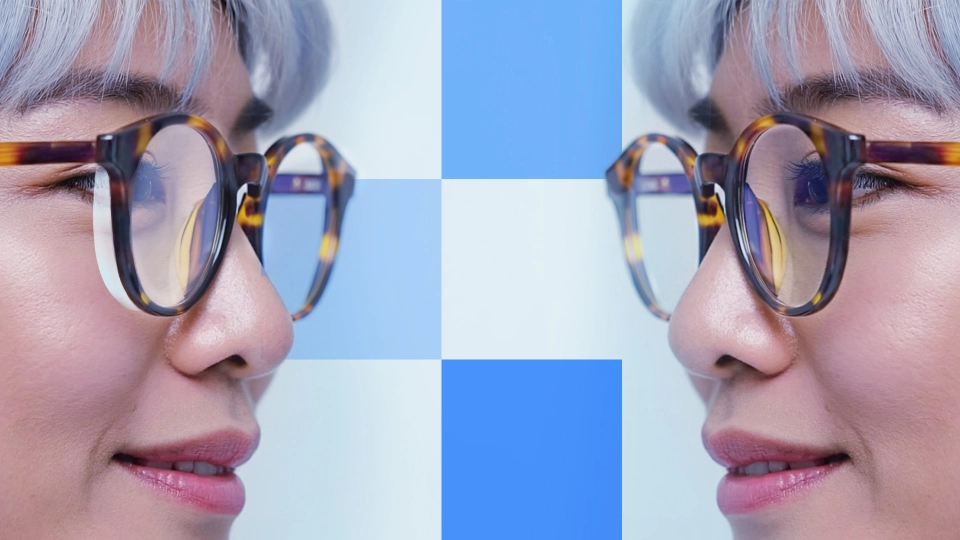
What Are High-Index Lenses? Benefits & Considerations
- What are high-index lenses?
- What is the refractive index?
- Abbe value and dispersion
- High-index lens material
- 1.60 index
- 1.67 index
- 1.74 index
- 1.90 index
- Prescription strength for high-index lenses
- Additional prescription considerations
- Benefits of high-index lenses
- Considerations of high-index lenses
- When to recommend high-index lenses
- 1. Prescription power
- 2. Frame and aesthetic considerations
- 3. Patient lifestyle factors
- Pioneering custom high-index lens designs

What Are High-Index Lenses? Benefits & Considerations
Traditional lenses can become bulky and cumbersome as prescription strength increases, especially for higher levels of hyperopia or myopia. Not only do many patients consider thicker lenses less aesthetically appealing, but they can also cause discomfort for patients who wear them all day. High-index lenses provide a solution: by using materials with a higher refractive index, the lens can bend light more efficiently, requiring less physical material to achieve the needed corrective power. This results in thinner, lighter, and more visually appealing lenses—attributes that stand out in a competitive marketplace.
What are high-index lenses?
High-index lenses are specialized optical lenses manufactured from materials that create thinner, lighter lenses while maintaining optical performance. They are usually used for patients with higher prescription strengths and refractive indexes (typically 1.6 and higher) to help reduce the bulky appearance of standard lenses at this strength.
The principle behind high-index lenses lies in their molecular structure. Traditional lens materials require greater thickness to achieve the necessary curvature for vision correction. In contrast, high-index materials feature a denser molecular arrangement that allows the lens to bend light more efficiently in a lens with reduced volume. Lenses with a higher index can accomplish the same level of refraction with less material thickness than a standard lens.
What is the refractive index?
The refractive index is a number that describes how fast light travels through a given material compared to a vacuum. The refractive index indicates how much light bends when it enters a new material. A higher refractive index means light moves more slowly and bends more sharply, which allows lenses to be thinner while still providing the same vision correction. In other words, the higher the refractive index, the less material is needed to achieve the desired prescription strength.
For example:
- A standard 1.50 lens might need a center thickness of around 3 mm for a given prescription.
- A 1.67 lens only needs 2 mm of material (or less) to achieve the same focusing power.
Abbe value and dispersion
Increasing a lens's refractive index to make it thinner also affects its Abbe value. The Abbe value measures how much the lens spreads out different colors of light, a process known as dispersion. When dispersion is high (meaning the Abbe value is low), it can cause color fringing, where faint colored halos appear around objects, especially near the edges of the lens.
However, lens design has improved significantly, and advanced designs, like aspheric and double aspheric surfaces, minimize this effect. These designs ensure crisp vision and comfort even at higher prescriptions.
High-index lens material
High-index lenses rely on materials that differ from standard lenses, with each option targeting a specific property or manufacturing requirement. Most high-index lenses are crafted from specialized polymers that balance refractive efficiency, durability, and comfort. Extremely high lens indexes often use ultra high-index glass. Lens index determines the chosen material’s quality:

1.60 index
As the entry point to high-index territory, 1.60 materials offer approximately a 20% reduction in thickness compared to standard CR-39 (1.50) lenses. These materials typically employ modified acrylic compositions with strategically incorporated additives to increase density. The 1.60 index balances improved cosmetics and production economics, making it suitable for mild to moderate prescriptions ranging from +3.00 to -5.75 diopters.
1.67 index
Like those at a 1.60 index, 1.67 lenses are also lightweight and comfortable for the wearer. However, materials at this index have a 30% thickness reduction compared to standard plastic. Most 1.67 lenses use specialized polycarbonate derivatives or proprietary polyurethane-based formulations. Their molecular structure contains higher concentrations of sulfur and other elements with high atomic numbers, improving the lens’ light-bending capabilities. These materials perform well in prescriptions from +4.75 to -6.75 diopters, offering substantial cosmetic and weight advantages without compromising optical performance.
1.74 index
Materials with a 1.74 index are some of the most advanced plastic-based lens materials, offering a 45% thickness reduction from standard lenses. These typically use complex co-polymers with precisely controlled molecular weight distributions. The manufacturing process for 1.74 materials requires stringent temperature control and specialized equipment, contributing to their higher production costs. These materials work for prescriptions from +5.00 to -7.00 diopters and beyond, though they may display increased chromatic aberration.
1.90 index
Ultra-high-index lenses are made from glass, as glass has a higher refractive level than plastic. Glass materials with indices of 1.90 and above often incorporate rare earth elements like lanthanum. These materials can achieve thickness reductions exceeding 60% compared to standard plastic but have impact resistance and weight trade-offs. Due to this trade-off, manufacturers reserve ultra-high index glass designs for extreme prescriptions exceeding -8.00 diopters where plastic-based alternatives would require excessive thickness.

Prescription strength for high-index lenses
High-index lenses work best when the patient’s spherical or cylindrical prescription strengths reach a point where a standard plastic lens (1.50) becomes thick or heavy. Specific thresholds are good guides for designs:
- +1.00 to -2.75: Standard 1.50 lenses are usually sufficient for low-prescription ranges.
- ±3.00 to ±5.75: A 1.60 or 1.67 index lens helps reduce thickness and weight while maintaining good visual quality.
- ±6.00 and above: A 1.67 or 1.74 index lens becomes a better choice to minimize edge or center thickness.
- Beyond ±7.00 or ±8.00: Some patients may consider 1.74 plastic or 1.90+ glass lenses.
Additional prescription considerations
While general recommendation states to use higher indices for stronger prescriptions, several additional factors are beneficial to consider when selecting appropriate high-index materials:
- Spherical component: For negative (myopic) prescriptions, lens edge thickness increases with prescription strength. High-index materials do a great job countering this effect. For positive (hyperopic) prescriptions, high-index lenses reduce the "magnifying glass" effect by making the center thinner.
- Cylindrical component: Astigmatism creates uneven thickness in lenses. Even moderate prescriptions with significant astigmatism of -2.00 or more often benefit from high-index materials to balance the lens profile.
- Prism component: When prism is prescribed for eye alignment issues, it adds thickness to one side of the lens. For every diopter of prism, approximately 0.1mm of thickness is added at the prism base. High-index materials help minimize this extra bulk, keeping glasses more comfortable and attractive.
- Frame selection interaction: Larger frames or frames that don't align with the patient's pupil distance create thicker edges. Sometimes, even a moderate prescription needs high-index lenses simply because the patient chose a large or wide frame.
Benefits of high-index lenses

High-index lenses offer advantages that extend beyond thickness reduction, providing value to both patients and eye care providers:
1. Improved aesthetics
High-index lenses allow the same or greater corrective power as standard CR-39 with less thickness. A slimmer lens avoids the “coke bottle/bug eye” effect in strong prescriptions. The improved aesthetics lead to greater patient satisfaction with their eye care providers.
2. Lighter weight
High-index lenses are lighter because they use less material. The weight reduction provides additional comfort for patients who wear glasses continuously. Reduced weight decreases the stress on the nasal bridge and ears, which can help prevent common complaints like red marks or headaches from extended wear.
3. Wider frame selection
Wearers with high prescriptions can feel limited when selecting frames. A standard plastic lens at -7.00 D might protrude from certain frame styles or be too heavy for a delicate look. Thinner lenses expand the range of trendy frame options available to the patient, including rimless or semi-rimless styles.
4. Suitable for complex designs
High-index materials work well with aspheric or double aspheric lens designs since they reduce peripheral distortions and provide a more expansive, clearer field of vision in higher prescriptions. This combination allows for flatter base curves, which make the lenses look thinner and also improve off-axis clarity.
5. UV protection and treatments
Many high-index materials inherently block 100% of UVA and UVB radiation without requiring additional treatments because of the polymer’s natural properties. High-index materials can still include anti-reflective, scratch-resistant, and photochromic coatings, making them flexible for patient preferences.
Considerations of high-index lenses

Despite their numerous advantages, high-index lenses present certain limitations and considerations that practitioners should recognize:
1. Higher cost
The specialized polymers used to achieve higher refractive indices typically cost more. For some patients, especially those on a tight budget, the cost difference between standard and high-index can be a stumbling block.
2. Potential for more surface reflections
As the refractive index increases, so does the lens’s inherent surface reflectance. This makes an anti-reflective coating almost required in a high-index lens. Without AR, patients may notice more distracting reflections or glare. While adding an AR coating is quite common in premium eyewear, it is an extra cost that some wearers might not anticipate.
3. Increased chromatic aberrations
High-index plastics generally have lower Abbe values than CR-39, increasing the risk of chromatic aberration, particularly in a wearer’s peripheral vision. While many patients may not notice this, those with high prescriptions see colored fringes around objects and reduced contrast. Some specialized lens designs and coatings can mitigate this effect, but it’s a limitation worth mentioning.
4. Durability and impact resistance
While modern high-index materials have substantially improved durability compared to early generations, they generally offer lower impact resistance than polycarbonate or Trivex. Impact resistance is less of an issue for typical day-to-day wear but could be relevant if the patient engages in high-risk activities. In safety cases, eye care professionals often recommend polycarbonate or Trivex over a super high-index material.
When to recommend high-index lenses
The decision to recommend high-index lenses should be made by considering multiple factors:
1. Prescription power
The most common use case is when a patient has a strong prescription strength, typically above ±3.00 D. High-index lenses help reduce edge thickness (for minus prescriptions) or center thickness (for plus prescriptions). The improved look and comfort typically outweigh the higher costs.
2. Frame and aesthetic considerations
High-index lenses are a great choice for patients who prioritize a sleek, modern look or want a variety of frames. Rimless and semi-rimless frames expose the lens edge and can only work with strong prescriptions when high-index materials are used. Frames with narrow bridges may produce uncomfortable weight concentrations without high-index lenses. Additionally, individuals who experience physical discomfort from heavy spectacles may find relief in lighter, higher-index lens options.
3. Patient lifestyle factors
Patients' daily activities could sway a decision about lens materials. Active patients may prioritize lightweight comfort. Wearers in professional environments with extended computer use can benefit from AR-coated high-index lenses. However, Sports and occupational safety eyewear might need to prioritize impact resistance over thinness.
Whether to recommend high-index lenses depends on balancing prescription strength, lifestyle factors, budget, and a patient’s aesthetic preferences. For manufacturers and labs, high-index materials unlock possibilities for creating a wide range of lens designs that cater to patients with strong prescriptions, style-forward preferences, or comfort needs.
Pioneering custom high-index lens designs
The technology behind high-index lenses determines how well they function and solve patients' optical requirements. IOT invests in being at the forefront of high-index lens designs so your lab can have a portfolio equipped to handle any patient request.
IOT produces semi-finished and finished high-index blanks that can be combined with advanced free-form designs or photochromic options, making the final product highly customizable. With additional free-form approaches, the proprietary Camber lens technology allows IOT to deliver a fully optimized lens surface so labs can fine-tune both lens curvature and thickness across the entire lens, achieving better cosmetic results and visual performance.
IOT’s treatments and coatings bring additional visual correction to wearers. The proprietary Neochromes combine photochromic design with high-index materials. Even at strong prescriptions in a variety of UV and light conditions, wearers experience fast-reacting, adaptable, and comfortable lenses. Neochromes are available worldwide and in North America in 1.6 and 1.67 in semi-finished and Neochromes Dark in 1.67.
Contact us to learn more about our high-index lens technology and how it can benefit your practice or lab.






